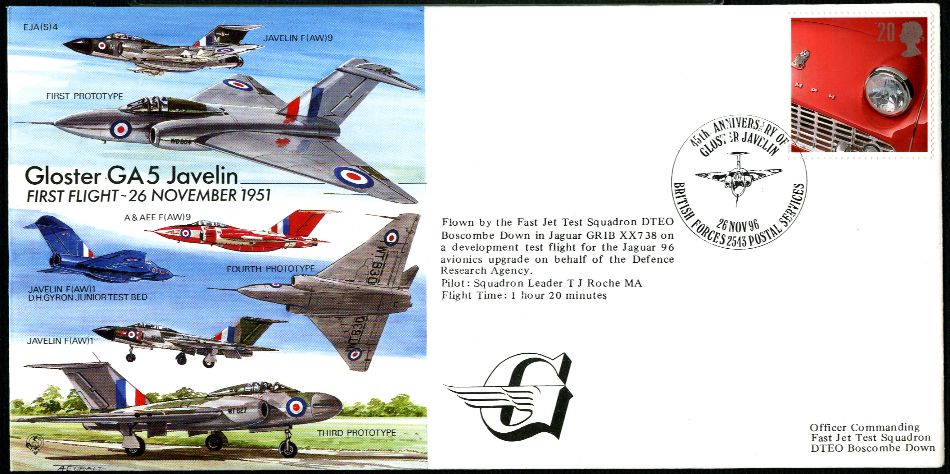 |
Gloster GA.5 Javelin First Flight 26th November 1951 RAF cover
 |
Gloster GA5 Javelin First Flight 26 November 1951 RAF cover
Cover produced for the 45th Anniversary of the Gloster Javelin.
Cover depicts the first, third and fourth prototypes, the Javelin F(AW)9, A&AEE F(AW)9, Javelin F(AW)1 and Javelin F(AW)1 DH Gyron Junior test bed. Cover bears 20p MPH stamp cancelled with BFPS 2543 for the 45th Anniversary of the Gloster Javelin.
Cover has been flown by the Fast Jet Test Squadron at DTEO Boscombe Down in Jaguar GR1B XX738 on a development test flight for the Jaguar 96 avionics upgrade on behalf of the defence research Agency.
In 1946 two Air Ministry specifications were issued F43/46 for a two seat interceptor and F44/46 for a two seater fighter. The Gloster Aircraft Company aware of the Delta winged configuration of the German engineer Herr Lippisch submitted two designs for consideration. Both featured the delta planform but having tailplanes.
The Metropolitan Vickers Sapphire F9 engine was chisen and under the designation 5 fighter prototypes and one trainer were ordered. Work on the prototype began in 1949. It was first taken to the air in July 1951 by Squadron Leader W A Waterton. The second prototype made its maiden flight in 21st August 1952. The third aircraft flew on 7th March 1953 and was armed with Aden cannon. In tests a need for a revised wing shape was found and so it flew with the revised wing on 28th May 1953. On 11 June it crashed killing the pilot as the wings stalled at low speed flight. The fourth prototype was modified to stop the stalling of the wings and made its maiden flight on 22nd July 1954. A contract had been issued for 40 Javelin aircraft and the first of these XA544 made its maiden flight on 22nd Jul 1954. The initial production aircraft entered service with 46 and 87 Squadrons. An improved version of the Javelion the F(AW) Mk2 first flew on 31st October with AI 22 American radar. Thirty aircraft were ordered and went to serve with 46, 85 and 89 Squadrons, a prototype was also ordered and went to A&AEE as a pacer aircraft receiving a fluorescent orange paint finish.
The original contract had called for a training version and design work had commenced in 1950. Designated the Javelin MK3 it made its first flight on 26th August 1956 retaining the gun armament and having a 44 inch extension to the front fuselage but no radar. Twenty three of this version were built with the initial batch being delivered to 228 OCU. To coumter the high stick forces a moving tail plane was designed and corporated in the Javelin F(AW)4, this was first flown by Peter Varley in February 1956. Restricted flight endurance was a problem and so XA641 was the first to have additional fuel tanks in the wing, retaining the radar ir also had pylons under the wings deisgned to carry four Firestreak air-to-air missiles. This was designated the Javelin F(AW) Mk5 and its first flight was 26th July 1956 piloted by R F Martin.
Javelin F(AW) Mk6 had its first flight 14 December 1956 piloted by R F Martin. With the next version an increase in power was required and Javelin F(AW) Mk7 made its first flight on 9th November 1956 also piloted by Dicky Martin The final Javelin version was also flown by Dicky Martin on 9 May 1958. IN addition to the 47 production aircraft, 76 Javelin Mk7s were brought up to Mk8 standard (these receiving the designation Javelin F(AW) Mk9) ONe of these XH897 received a striking colour scheme of red and white and after a period at the A&AEE as a pacer aircraft was retired ti the Imperial War Museum at Duxford.
In June 1967, 60 and 64 Squadrons flew a final flypast of 14 Javelins being the last unit to operate the type